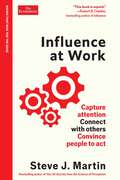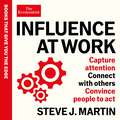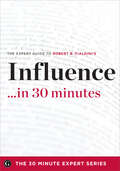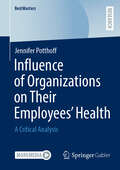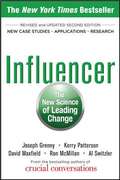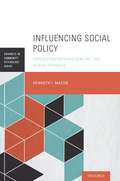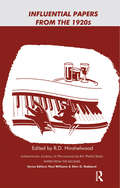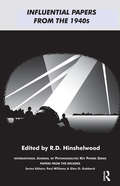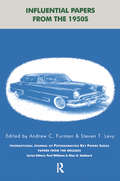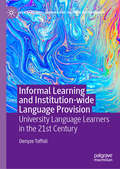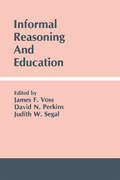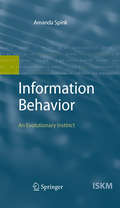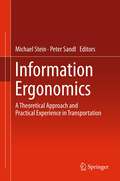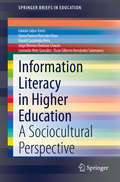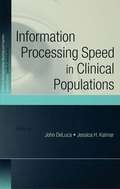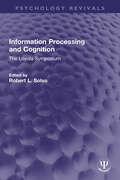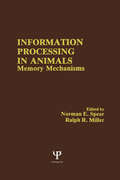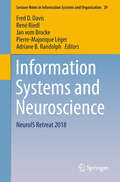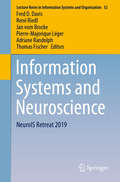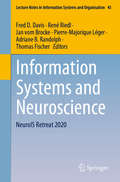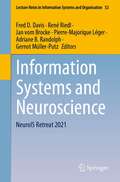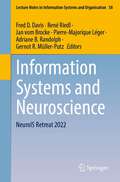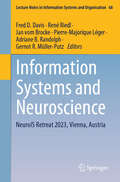- Table View
- List View
Influence at Work: Capture attention, connect with others, convince people to act (The Economist Edge Series)
by Steve J. MartinFrom the New York Times bestselling author on the psychology of persuasion: a brilliant new guide to improving your influence at work—and beyond.To be successful at work you also need to be influential at work. And to be influential requires an understanding of how the rules of influence work. Not just those mandated by logic, economics and company policy. But the unspoken rules too. The rules people rarely talk about, but that frequently have an out-sized impact on who and what gets listened to and done, and who and what gets ignored. Recognising and navigating these rules of influence is crucial to your persuasive success. Influence at Work shows you what these rules are and how to effectively deploy them to command attention; connect with others; win over the sceptics; sway the undecided; and motivate people to act. The result is a new guide to an age-old subject: what influence is, why it matters, and how to use it wisely and ethically.
Influence at Work: Capture attention, connect with others, convince people to act: An Economist Edge book
by Steve J. MartinTo be successful at work you also need to be influential at work.And to be influential requires an understanding of how the rules of influence work. Not just those mandated by logic, economics and company policy. But the unspoken rules too. The rules people rarely talk about, but that frequently have an out-sized impact on who and what gets listened to and done, and who and what gets ignored. Recognising and navigating these rules of influence is crucial to your persuasive success.Influence at Work shows you what these rules are and how to effectively deploy them to command attention; connect with others; win over the sceptics; sway the undecided and motivate people to act.The result is a new guide to an age-old subject: what influence is, why it matters, andhow to use it wisely and ethically.
Influence in 30 Minutes: The Expert Guide to Robert B. Cialdini's Critically Acclaimed Book
by Garamond PressInfluence ...in 30 minutes is your guide to quickly understanding the important lessons on influencing human behavior covered in the best seller, Influence: The Psychology of Persuasion. In Influence: The Psychology of Persuasion, Dr. Robert B. Cialdini uses decades of research and experiments to offer insight into the psychology of human decision-making, and the world of influence and persuasion. In Influence, Cialdini reveals invaluable tools for everyone from consumers to professional salespeople, including how to become a skilled persuader and how to counteract manipulation. Widely praised for its practical knowledge, Influence: The Psychology of Persuasion is incredibly useful for anyone seeking to understand the psychology behind why people say yes. Use this helpful guide to understand Influence in a fraction of the time, with tools such as: Fundamentals of how to harness the power of persuasion to influence others Practical applications for using the "six weapons of influence" to move others to say yes Techniques for defending against manipulation tactics used by advertisers, salespeople, swindlers, or even friends and colleagues Intriguing case studies, a brief synopsis, and definitions of key terms from Influence As with all books in the 30 Minute Expert Series, this book is intended to be purchased alongside the reviewed title, Influence: The Psychology of Persuasion.
Influence of Organizations on Their Employees’ Health: A Critical Analysis (BestMasters)
by Jennifer PotthoffThe modern working world, characterized by a VUCA-world, digitalization, and demographic change, is transforming the way of working, offering benefits like increased flexibility but also bringing uncertainty, constant change, and new tasks. These developments pose new challenges to leaders and employees, reflected in rising sick days in Germany. Given the financial damage of presenteeism and absenteeism for individual companies and the German economy, organizations must find ways to maintain their employees’ mental and physical health. Despite the growing importance of health in the corporate context, in Germany the potential of workplace health promotion is not yet fully exploited. This book highlights how modern behavioral economic incentive systems, using psychological insights on people’s real decision-making behavior, can enhance corporate health promotion. Jennifer Potthoff designed the MIND-THE-GAP-toolbox for organizations to motivate their employees to eat healthier, improve physical activity, and reduce stress at work. Additionally, the book discusses how leaders can support employee health through a health-oriented leadership style characterized by self-care, mindfulness, staff-care, appreciation, empathy, trust, communication, fairness, and a balance between scope for action and task orientation.
Influence: Science and Practice (5th edition)
by Robert B. CialdiniWhat factors cause someone to say yes? And which techniques most effectively use these factors to bring about such compliance? In his best-selling book, Robert Cialdini, former salesperson, fund-raiser, and advertiser, and current professor of social psychology, examines the science and practice of persuasion and compliance. Praised for its enjoyable writing, practical suggestions, and scientifically documented content, prior editions have been widely read by business professionals, fund-raisers, and those interested in psychology.
Influencer: The New Science of Leading Change (2nd Edition)
by Kerry Patterson Joseph Grenny Ron Mcmillan Al Switzler David MaxfieldA thought-provoking book that combines the remarkable insights of behavioral scientists and business leaders with the astonishing stories of high-powered influencers from all walks of life.
Influencing Social Policy: Applied Psychology Serving the Public Interest (Advances In Community Psychology Ser.)
by Kenneth I. MatonInfluencing Social Policy synthesizes current knowledge about how psychologists influence social policy to serve the public interest. The volume builds upon interviews with 79 applied psychologists about their experiences in the policy domain, with special focus on the work of applied developmental psychologists, applied social psychologists, and community psychologists. Additional foundations of the volume include a review of social science scholarship across a wide range of disciplines, and author Kenneth Maton's 30 years of teaching on the topic, including frequent interactions with Washington, DC, policy experts. <P><P>Together, these sources provide in-depth information about how applied psychologists influence social policy, the factors that contribute to their success, the challenges they face, and the approaches used to address those challenges. The policy influences described span all three branches of government: legislative, executive, and judicial. The policy content areas are diverse, including the death penalty prohibition for adolescents, early childhood education, gay marriage, gender discrimination in the workplace, health and mental health care reform, homelessness, home visiting programs, sexually abused child witness treatment, status offender diversion from the juvenile justice system, substance abuse prevention, and many others. Influencing Social Policy is a must-have resource for graduate students and professionals in a wide variety of disciplines with interests in influencing social policy, including psychology, education, public health, social work, policy studies, anthropology, and sociology.
Influential Papers from the 1920s (The IJPA Key Papers Series)
by R.D. HinshelwoodThe 1920s was the decade when psychoanalysis moved from the fringes of accepted medical practice into the mainstream. It also witnessed the birth of the English-language International Journal of Psychoanalysis. Freud continued to dominate the psychoanalytic arena with his continuing innovations and expansion of ideas but topics of interest outside of his inspiration also grew. The influx of women into the profession led to new discussions on female sexuality and, possibly, to greater interest in psychoanalysing children. The papers in this volume deal with substantial issues in the development of psychoanalysis that still have profound echoes in psychoanalytic discussion today. Beautifully edited, with the papers divided into their subject matter and contextualised through comprehensive and clear introductions, this is an essential anthology of classic papers with contributions from Karl Abraham, Sandor Ferenczi, Anna Freud, Edward Glover, Karen Horney, Ernest Jones, Melanie Klein, Joan Rivière, and Hermine von Hug-Helmuth.
Influential Papers from the 1940s (The IJPA Key Papers Series)
by R.D. HinshelwoodThe 1940s was a time of great change in the psychoanalytic world. The war sounded a deathblow to continental European psychoanalysis and the death of Freud at first brought uncertainty over the future of psychoanalysis but ultimately led to greater creative freedom in exploring new ideas and theories.
Influential Papers from the 1950s (The IJPA Key Papers Series)
by Andrew C. Furman Steven T. LevyThis volume presents a series of papers that appeared in the International Journal of Psycho-Analysis during the 1950s. It recognizes a turning of psychoanalytic attention from the exploration of the analysand's intra-psychic experience to mapping out equally relevant psychoanalytic concerns.
Informal Caregivers: From Hidden Heroes to Integral Part of Care
by Andreas CharalambousThis book builds on the current trends in informal caregivers’ role in the supportive care of cancer patients (as well as other diseases) across the care continuum covering topics from the healthcare professionals and the users’ perspectives. Informal caregivers are a critical resource to their care recipients and an essential component of the health care system. The book introduces a comprehensive view of the topic and acknowledges the importance and the complexity of caregiving. Here lays one of the uniqueness of this book, which highlights the areas and the ways that for example interventions in specific settings/groups of patients can actually facilitate the caregiving process. The increasing number of care-dependent people, the adoption of the principle “outpatient before inpatient”, the shift of care from inpatient to outpatient and the preference for home care (i.e. majority) are only some of the reasons that contributed to Informal caregiving becoming a central feature of the health care landscape and will become even more prominent in the decades ahead. The book draws on the experts’ high-end, current systematic research evidence and real-life examples on these topics to provide an insightful perspective on undertaking research within this context, and to demonstrate informal caregivers’ impact on patients’ outcomes. The structure of the book provides multiple perspectives to the topic and makes it appealing to a wide range of recipients including the nursing community, clinicians, social workers, researchers, policy makers, technology experts as well as postgraduate students especially to those practicing specifically in supportive care in cancer. The book fills a gap in this field of expertise not only by familiarizing the reader with a wide range of topics to be considered but it also emphasizes on what the developments in the field in the future would need to take into consideration. Finally, current and future studies can be informed from the practices of preceding studies that are incorporated in the book.
Informal Learning and Institution-wide Language Provision: University Language Learners in the 21st Century (New Language Learning and Teaching Environments)
by Denyze Toffoli“Theoretically wise and practically powerful, this book is about how to take full advantage of advances in technology and the learner autonomy they afford, rather than simply adapt to or deny them. It issues a clarion call to language educators and administrators interested in building on recent advances in language learning via the informal avenues of digital communications.” --Mark Dressman, Professor Emeritus, University of Illinois at Urbana-Champaign, US, Professor and Chair of English at Khalifa University, UAE “This important and original book challenges us to rethink the design and delivery of the language learning opportunities universities provide for their students. Drawing on Complex Dynamic Systems Theory, Self-Determination Theory and her own empirical explorations of informal online language learning, Denyze Toffoli paints a portrait of today’s university language learner that is novel, unexpected and urgent.” --David Little, Fellow and Associate Professor Emeritus at Trinity College, IrelandThis book takes a fresh look at both context and the language learner in an attempt to shed light on the holistic and ever-changing system of the contemporary L2 speaker’s language development. Drawing on complex dynamic systems theory as a means to more fully understand the holistic nature of contemporary language learning, the author attempts to bridge the longstanding gap between formal language provision in Higher Education institutions, and more informal language acquisition achieved through activities such as listening to music, watching films and television, and playing games. Based on a theoretical understanding of the interplay between these contexts, contents and practices, the author offers suggestions concerning the shape of language centres in higher education and the role of teachers in readying the contemporary language learner for autonomous lifelong and lifewide language development. This book will be of particular interest to language teachers, teacher trainers, and higher education administrators.
Informal Reasoning and Education
by James F. Voss David N. Perkins Judith W. SegalBased on extensive reasoning acquisition research, this volume provides theoretical and empirical considerations of the reasoning that occurs during the course of everyday personal and professional activities. Of particular interest is the text's focus on the question of how such reasoning takes place during school activities and how students acquire reasoning skills.
Information Behavior
by Amanda SpinkInformation behavior has emerged as an important aspect of human life, however our knowledge and understanding of it is incomplete and underdeveloped scientifically. Research on the topic is largely contemporary in focus and has generally not incorporated results from other disciplines. In this monograph Spink provides a new understanding of information behavior by incorporating related findings, theories and models from social sciences, psychology and cognition. In her presentation, she argues that information behavior is an important instinctive sociocognitive ability that can only be fully understood with a highly interdisciplinary approach. The leitmotivs of her examination are three important research questions: First, what is the evolutionary, biological and developmental nature of information behavior? Second, what is the role of instinct versus environment in shaping information behavior? And, third, how have information behavior capabilities evolved and developed over time? Written for researchers in information science as well as social and cognitive sciences, Spink's controversial text lays the foundation for a new interdisciplinary theoretical perspective on information behavior that will not only provide a more holistic framework for this field but will also impact those sciences, and thus also open up many new research directions.
Information Ergonomics: A theoretical approach and practical experience in transportation
by Michael Stein Peter SandlThe variety and increasing availability of hypermedia information systems, which are used in stationary applications like operators' consoles as well as mobile systems, e.g. driver information and navigation systems in automobiles form a foundation for the mediatization of the society. From the human engineering point of view this development and the ensuing increased importance of information systems for economic and private needs require careful deliberation of the derivation and application of ergonomics methods particularly in the field of information systems. This book consists of two closely intertwined parts. The first, theoretical part defines the concept of an information system, followed by an explanation of action regulation as well as cognitive theories to describe man information system interaction. A comprehensive description of information ergonomics concludes the theoretical approach. In the second, practically oriented part of this book authors from industry as well as from academic institutes illustrate the variety of current information systems taken from different fields of transportation, i.e. aviation, automotive, and railroad. The reader thus gains an overview of various applications and their context of use as well as similarities and differences in design. This does not only include a description of the different information systems but also places them in the context of the theories and models, which were presented in the first part of this book.
Information Literacy in Higher Education: A Sociocultural Perspective (SpringerBriefs in Education)
by Fabiola Cabra-Torres Gloria Patricia Marciales Vivas Harold Castañeda-Peña Jorge Winston Barbosa-Chacón Leonardo Melo González Oscar Gilberto Hernández SalamancaThis book presents an innovative theoretical and methodological approach to study information literacy in higher education contexts. While mainstream studies tend to see information literacy as a technical and universal process, this book proposes a theoretical and methodological framework to study information literacy from a sociocultural perspective, highlighting the importance of the social and cultural contexts in which information literacy develops.This situated approach demands that research data must be analysed in relation to the contexts in which they emerge, so the book proposes a research method based on the study of personal histories and stories, learning situations and intersubjective relationships to characterize the different information profiles of different information users. Adopting a multidisciplinary approach that combines contributions from educational research, psychology and information sciences, the authors first present a theoretical discussion to argue in favor of the sociocultural paradigm to study information literacy, then present their methodological proposal to observe informational competencies among higher education students, and finally present the results of an empirical study to identify different information literacy profiles among Latin American students and teachers.Breaking with the hegemonic paradigm in the field, Information Literacy in Higher Education – A Sociocultural Perspective provides useful and innovative tools to researchers working in different areas of the social sciences, such as education, psychology, linguistics and information sciences.
Information Processing Speed in Clinical Populations (Studies on Neuropsychology, Neurology and Cognition)
by John DeLuca Jessica H. KalmarAlthough investigated for over 100 years, it is only now that we are beginning to understand how speed of information processing is affected in various clinical populations. Processing speed has a major impact on higher level cognitive abilities and is extremely vulnerable to neurological insult and the aging process. The importance of processing speed with respect to brain function, cognition and overall quality of life is now the focus of a new and exciting body of research in clinical populations. This book provides a scholarly and clinically sensitive review of research on processing speed and its issues in clinical populations. Readers will come away with an in-depth understanding of human information processing speed including its historical development, its relationship to other cognitive functions, the developmental course of the ability across the lifespan, and its impact on everyday life in various clinical populations. Other highlights of the text are its discussion of the speed vs. accuracy trade-off, tools available for measuring processing speed, the unfolding research on genetic contributions to processing speed, and the latest ideas in rehabilitation. With contributing authors who are experts in their fields, Information Processing Speed in Clinical Populations represents a valuable resource for researchers, scholars, and clinicians by providing a concise summary of the existing research on processing speed across an array of disciplines and populations.
Information Processing and Cognition: The Loyola Symposium (Psychology Revivals)
by Robert L. SolsoOriginally published in 1975, this title presented current theories in information processing and cognition at the time. The topics fall into three major groups. The first section is concerned with the issues of perception and initial processing of visual material; the second section is addressed to problem of storage, retrieval, and consciousness in memory; the final section is related to the processing of language.
Information Processing in Animals: Memory Mechanisms
by Ralph R. Miller Norman E. SpearFirst published in 1982. During the past fifty years, dramatic changes have occurred in the use of laboratory animals to study learning and memory. Yet the basic reasons for this research, diverse as they are, have not changed. At one extreme is the need for relatively direct application of findings with animal models to medical or educational problems of humans; at the other extreme, the quest for understanding animal behavior for its own sake. It is probably fair to say that no chapters in this book represent either of these extremes, although in each case the author’s purposes can be said to be like those of some scientists working in this area fifty years ago. In contrast to this continuity of purpose, the approach that scientists now take in this area of study is really quite different from that of most or all scientists in the 1930s.
Information Systems and Neuroscience: Gmunden Retreat On Neurois 2016 (Lecture Notes in Information Systems and Organisation #16)
by Jan Vom Brocke René Riedl Pierre-Majorique Léger Fred D. Davis Adriane B. RandolphThis book presents the proceedings of the NeuroIS Retreat 2018, June 19-21, Vienna, Austria, reporting on topics at the intersection of Information Systems (IS) research, neurophysiology and the brain sciences. Readers will discover the latest findings from top scholars in the field of NeuroIS, which offer detailed insights on the neurobiology underlying IS behavior, essential methods and tools and their applications for IS, as well as the application of neuroscience and neurophysiological theories to advance IS theory.
Information Systems and Neuroscience: NeuroIS Retreat 2019 (Lecture Notes in Information Systems and Organisation #32)
by Thomas Fischer Jan Vom Brocke René Riedl Pierre-Majorique Léger Fred D. Davis Adriane RandolphThis book presents the proceedings of the NeuroIS Retreat 2019, held on June 4–6 in Vienna, Austria, reporting on topics at the intersection of information systems (IS) research, neurophysiology and the brain sciences. Featuring the latest findings from top scholars in the field, it offers detailed insights into the neurobiology underlying IS behavior, essential methods and tools and their applications for IS, as well as applying neuroscience and neurophysiological to advance IS theory.
Information Systems and Neuroscience: NeuroIS Retreat 2020 (Lecture Notes in Information Systems and Organisation #43)
by Thomas Fischer Jan Vom Brocke René Riedl Pierre-Majorique Léger Fred D. Davis Adriane B. RandolphThis book presents the proceedings of the virtual conference NeuroIS Retreat 2020, June 2–4, hosted in Austria, reporting on topics at the intersection of information systems (IS) research, neurophysiology and the brain sciences. Readers will discover the latest findings from top scholars in the field of NeuroIS, which offer detailed insights on the neurobiology underlying IS behavior, essential methods and tools and their applications for IS, as well as the application of neuroscience and neurophysiological theories to advance IS theory.
Information Systems and Neuroscience: NeuroIS Retreat 2021 (Lecture Notes in Information Systems and Organisation #52)
by Jan Vom Brocke René Riedl Pierre-Majorique Léger Fred D. Davis Adriane B. Randolph Gernot Müller-PutzThis book presents the proceedings of the NeuroIS Retreat 2021, June 1-3, virtual conference, reporting on topics at the intersection of information systems (IS) research, neurophysiology and the brain sciences. Readers will discover the latest findings from top scholars in the field of NeuroIS, which offer detailed insights on the neurobiology underlying IS behavior, essential methods and tools and their applications for IS, as well as the application of neuroscience and neurophysiological theories to advance IS theory.
Information Systems and Neuroscience: NeuroIS Retreat 2022 (Lecture Notes in Information Systems and Organisation #58)
by Jan Vom Brocke René Riedl Pierre-Majorique Léger Fred D. Davis Adriane B. Randolph Gernot R. Müller-PutzThis book presents the proceedings of the NeuroIS Retreat 2022, June 14-16, Vienna, Austria, reporting on topics at the intersection of information systems (IS) research, neurophysiology and the brain sciences. Readers will discover the latest findings from top scholars in the field of NeuroIS, which offer detailed insights on the neurobiology underlying IS behavior, essential methods and tools and their applications for IS, as well as the application of neuroscience and neurophysiological theories to advance IS theory.
Information Systems and Neuroscience: NeuroIS Retreat 2023, Vienna, Austria (Lecture Notes in Information Systems and Organisation #68)
by Jan Vom Brocke René Riedl Pierre-Majorique Léger Fred D. Davis Adriane B. Randolph Gernot R. Müller-PutzThis book presents the proceedings of the NeuroIS Retreat 2023, May 30–June 1, Vienna, Austria, reporting on topics at the intersection of information systems (IS) research, neurophysiology and the brain sciences. Readers will discover the latest findings from top scholars in the field of NeuroIS, which offer detailed insights on the neurobiology underlying IS behavior, essential methods and tools and their applications for IS, as well as the application of neuroscience and neurophysiological theories to advance IS theory.
